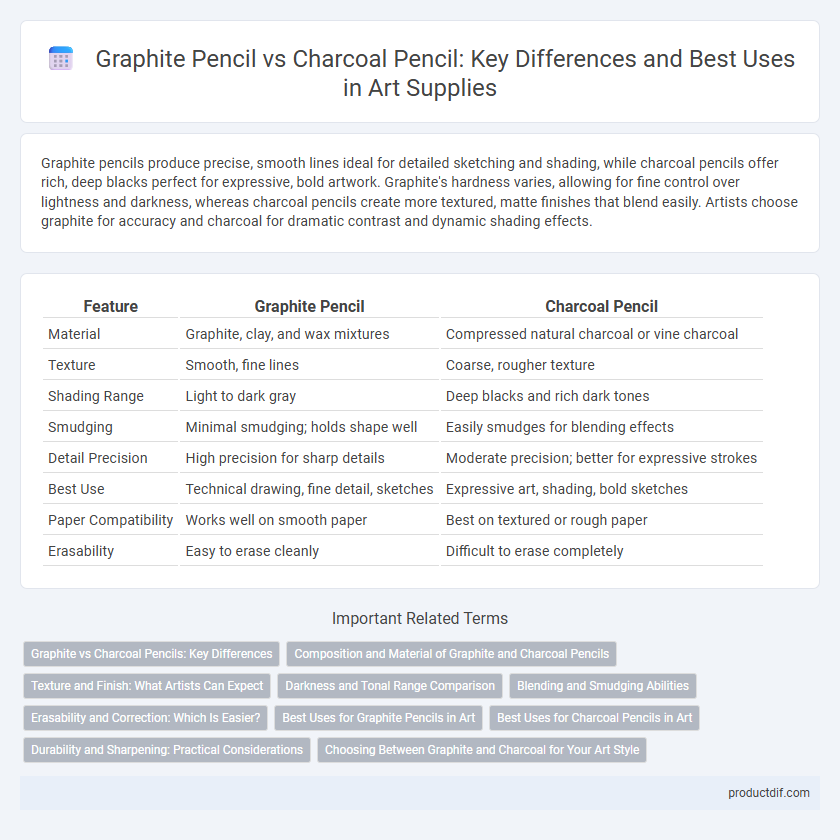Graphite pencils produce precise, smooth lines ideal for detailed sketching and shading, while charcoal pencils offer rich, deep blacks perfect for expressive, bold artwork. Graphite's hardness varies, allowing for fine control over lightness and darkness, whereas charcoal pencils create more textured, matte finishes that blend easily. Artists choose graphite for accuracy and charcoal for dramatic contrast and dynamic shading effects.
Table of Comparison
| Feature | Graphite Pencil | Charcoal Pencil |
|---|---|---|
| Material | Graphite, clay, and wax mixtures | Compressed natural charcoal or vine charcoal |
| Texture | Smooth, fine lines | Coarse, rougher texture |
| Shading Range | Light to dark gray | Deep blacks and rich dark tones |
| Smudging | Minimal smudging; holds shape well | Easily smudges for blending effects |
| Detail Precision | High precision for sharp details | Moderate precision; better for expressive strokes |
| Best Use | Technical drawing, fine detail, sketches | Expressive art, shading, bold sketches |
| Paper Compatibility | Works well on smooth paper | Best on textured or rough paper |
| Erasability | Easy to erase cleanly | Difficult to erase completely |
Graphite vs Charcoal Pencils: Key Differences
Graphite pencils produce smooth, precise lines with varying hardness levels ideal for detailed sketches and fine shading, while charcoal pencils offer rich, deep blacks and a textured, expressive quality suited for bold, dramatic artwork. Graphite is less smudgy and allows for easier erasing compared to charcoal, which tends to be messier but creates more intense contrast and tonal depth. Artists choose graphite for controlled, clean drawings and charcoal for dynamic, moody effects emphasizing strong light and shadow interplay.
Composition and Material of Graphite and Charcoal Pencils
Graphite pencils contain a core made of a mixture of graphite and clay, where the ratio of these materials determines the hardness and darkness of the marks produced. Charcoal pencils are composed of compressed natural charcoal or charcoal powder bound with a gum or wax binder, offering richer blacks and a more textured, matte finish. The inherent differences in material composition affect blending properties, durability, and the ability to create fine details in artwork.
Texture and Finish: What Artists Can Expect
Graphite pencils produce smooth, fine lines and a glossy finish that allows for precise detailing and subtle shading. Charcoal pencils create rich, bold textures with a matte, velvety surface ideal for expressive, dramatic effects and deep contrasts. Artists seeking control and refinement often prefer graphite, while those aiming for dynamic, textured compositions choose charcoal.
Darkness and Tonal Range Comparison
Graphite pencils offer a broad tonal range with smooth transitions from light grays to deep blacks but tend to produce a shinier finish at darker values. Charcoal pencils provide richer, more intense blacks with a matte texture, enabling deeper shadows and dramatic contrasts ideal for expressive artwork. The choice between graphite and charcoal hinges on desired darkness intensity and tonal flexibility, with charcoal excelling in dark depth and graphite delivering refined gradient control.
Blending and Smudging Abilities
Graphite pencils offer smooth blending with a subtle gradation, making them ideal for detailed shading and fine textures in artwork. Charcoal pencils excel in rich, dark tones and provide superior smudging capabilities, allowing artists to create dramatic contrasts and expressive, bold strokes. The choice between graphite and charcoal depends on the desired effect, with graphite favoring precision and charcoal delivering intense, easily blendable shadows.
Erasability and Correction: Which Is Easier?
Graphite pencils offer superior erasability and correction compared to charcoal pencils, as graphite particles sit more lightly on paper and can be removed cleanly with a standard eraser. Charcoal pencils, known for their rich, deep blacks, tend to embed pigment more deeply into paper fibers, making them harder to erase and correct without smudging. Artists seeking precise modification often prefer graphite pencils for their ease of correction during sketching and detailed work.
Best Uses for Graphite Pencils in Art
Graphite pencils excel in rendering fine details and smooth gradients, making them ideal for realistic drawings, architectural sketches, and precise line work. Their ability to produce a wide range of tones from light gray to deep black allows artists to achieve subtle shading and intricate textures. Graphite pencils are preferred for detailed portrait work, technical illustrations, and preliminary sketches due to their control and erasability.
Best Uses for Charcoal Pencils in Art
Charcoal pencils excel in creating rich, deep blacks and dramatic contrasts, making them ideal for expressive portrait sketches and dynamic figure drawings. Their ability to produce bold, textured strokes allows artists to achieve a range of tonal variations and atmospheric effects in landscapes and abstract compositions. Unlike graphite pencils, charcoal pencils are preferred for emphasizing shadows and dramatic lighting due to their softer, more blendable medium.
Durability and Sharpening: Practical Considerations
Graphite pencils maintain their shape longer and require less frequent sharpening, making them ideal for detailed, precise work. Charcoal pencils wear down quickly due to their softer composition, necessitating more frequent sharpening and careful handling to preserve the tip. Durability differences impact workflow efficiency, with graphite favored for extended drawing sessions and charcoal suited for expressive, bold marks.
Choosing Between Graphite and Charcoal for Your Art Style
Graphite pencils offer precise lines, smooth shading, and a wide tonal range ideal for detailed realism, while charcoal pencils provide rich, deep blacks and expressive textures suited for bold, dynamic sketches. Artists seeking fine control and subtle gradients often prefer graphite, whereas those aiming for dramatic contrasts and a more tactile surface choose charcoal. Understanding your preferred style and desired effects is key to selecting the right medium for your artwork.
Graphite pencil vs Charcoal pencil Infographic

 productdif.com
productdif.com